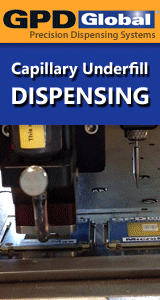| | I am a new employee at a company that has had a large turnover of employees over the past year. I am working on a board (components on one side only), the engineer (he is also new ) wants to use an .035 pad with a .021 dia. hole, there are no via's under the zero clearance components. But manufacturing wants to use an .035 pad with a .012 dia. hole because the solder is wicking up so high the assembler is saying there's a problem (with the non-zero clearence components), is the problem with the solder bath level? and if so isn't this level easy to change? | | | Frank, | I think I understand you correctly, that you have solder wicking up through via holes....and you dont want this. If that is the case then have them coated in solder resist on your next purchase and apply temporary resist (spot mask/masking dots)prior to process. | As far as solder bath level is concerned, if you are processing a standard (??) 1.6mm board, the level should ideally be set to come half way up the board edge. You can check this with something like a LEV-CHECK which is a graticuled "glass" which allows you to check your wave characteristics simply. | | Hope this helps and that I have understood your question correctly. If not sorry, but it's been a long day full of preprod meetings. Someone else may interpret your question differently. | | Regards, | | Chris. | | Chris is right. However, the size of the via is not material to your problem. The solder will still wick up, even if the hole is 1 mm diameter, because (hopefully) it wets the copper in the hole. I would not recommend a hole as large as your engineer suggests, as this will leave a ring of only 0,18 mm which is a wee bittie tight, especially for your PCB manufacturer. It is important that you consult him to find out his optimum for manufacturability: I would guess he would say about 0,4 mm, give or take an ounce or two. After all, it is he who would have the most problems if the drilling diameter is either too big or too small, not you, so listen to him, please, before you make any arbitrary decision. (Read what Earl Moon has had to say about DFM in SMT Express.)
reply »
![]()
![]() I am a new employee at a company that has had a large turn...
- Oct 05, 1999
by
I am a new employee at a company that has had a large turn...
- Oct 05, 1999
by
![]()
![]() | I am a new employee at a company that has had a large tu...
- Oct 05, 1999
by
Chris May
| I am a new employee at a company that has had a large tu...
- Oct 05, 1999
by
Chris May
![]()
![]()
![]() | | I am a new employee at a company that has had a large ...
- Oct 06, 1999
by
| | I am a new employee at a company that has had a large ...
- Oct 06, 1999
by







